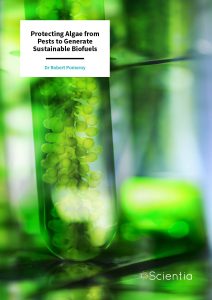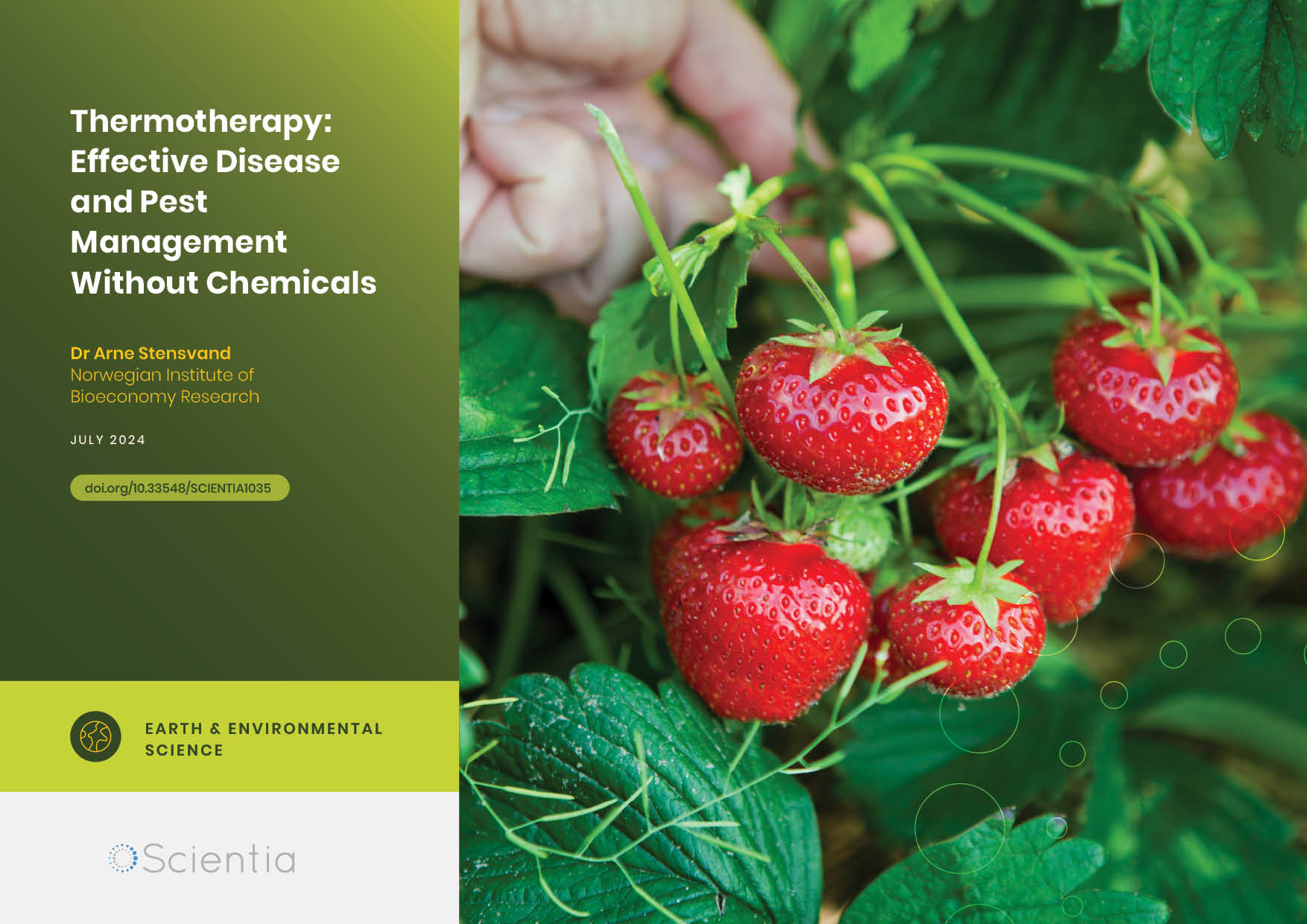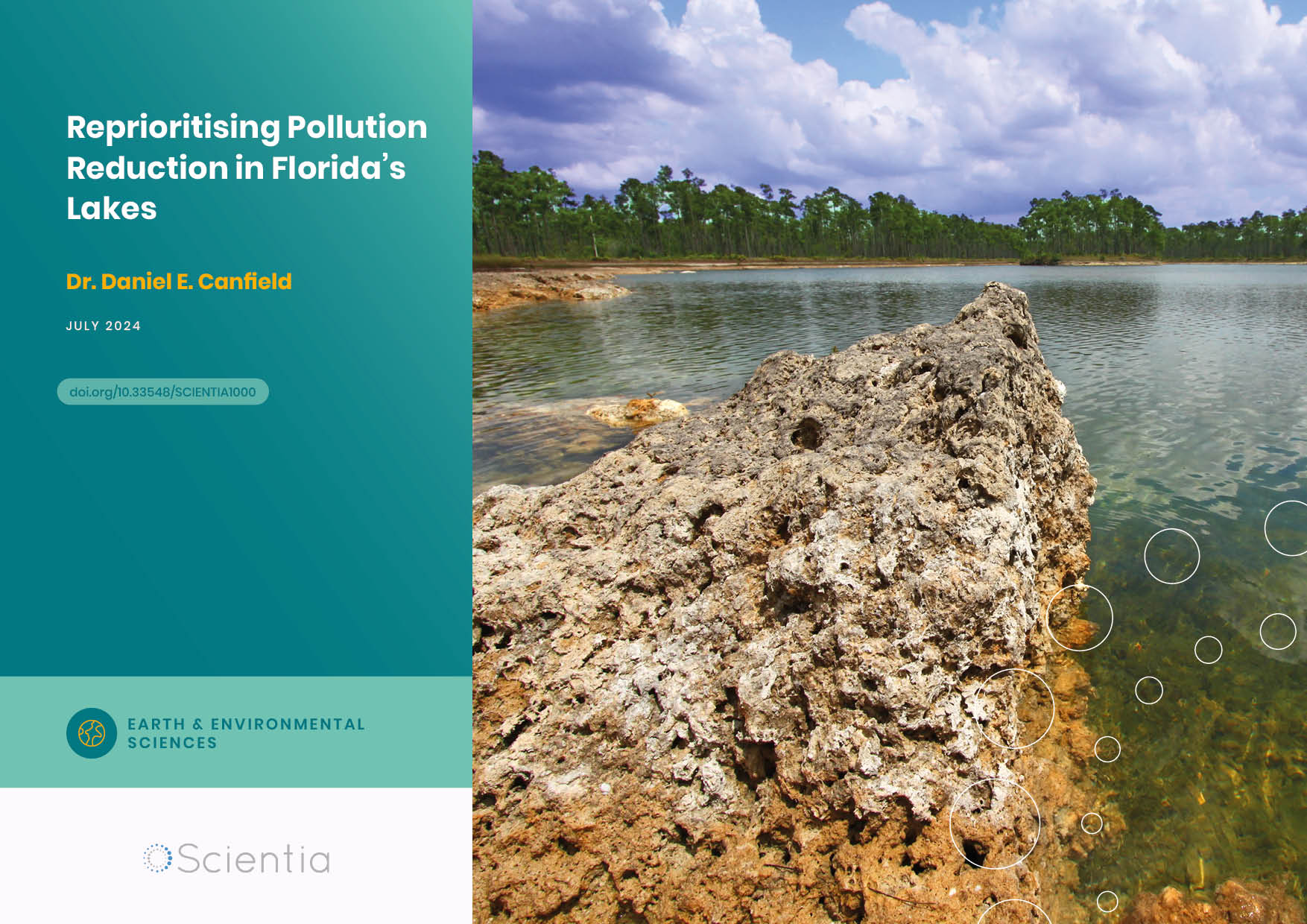Dr Robert Pomeroy | Protecting Algae from Pests to Generate Sustainable Biofuels
Algal biofuels offer a renewable and carbon-neutral alternative to fossil fuels. These photosynthetic microorganisms can be grown inexpensively in large ponds, but being exposed to the elements risks biological contamination from other microorganisms. Dr Robert Pomeroy and colleagues at the University of California, San Diego, used chemical ionisation mass spectrometry to continuously measure the quantities and compositions of volatile gases produced by algal pond samples, allowing for the detection of infectious species and assessment of the impact such pests have on algal communities.
As the world transitions towards renewable energy sources, biomass is an important source of biofuel for the energy industry and chemical production (including dyes, cosmetics, pharmaceuticals and food additives). Biofuels can be made from algae, plants or biowaste generated by agricultural, industrial and domestic settings, providing oils that are alternative energy sources to the fossil fuels causing climate change.
Cultivating algae in shallow, artificial (raceway) ponds is an economical method of generating the biomass needed for biofuels through the process of photosynthesis (where organisms containing the green pigment chlorophyll produce energy from sunlight, water and carbon dioxide). However, ponds often contain biological contamination from grazing species which reduce biomass quantities through competition between algal species and risks posed by infectious organisms.
Dr Robert Pomeroy and his colleagues at the University of California, San Diego, identified an important need for regular, real-time pond observations to detect infections introduced by grazing microorganisms as soon as possible so that action can be taken quickly to protect pond algae populations.
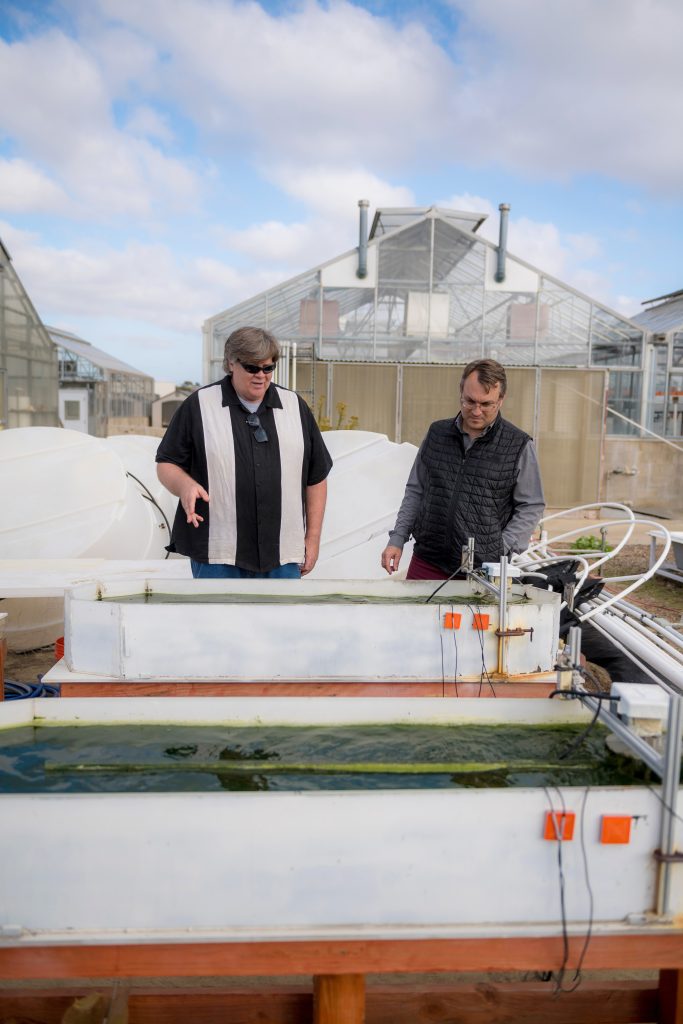
Credit: Erik Jepson
Detecting Infections to Save Crops
Microalgae can be grown rapidly in small spaces, with few additional resources, to produce large quantities of biomass, making them a sustainable energy source. Algae are often grown in open raceway ponds, with a paddle wheel to maintain water flow, as operational costs are significantly lower than for the laboratory cultivation of biomass. However, the lack of environmental controls on open ponds means that contamination by grazing species [such as viruses, bacteria, fungi and other microorganisms (ciliates and rotifers)] poses a significant challenge to growers. In fact, infections introduced by grazing species can decrease biomass yields by 10 to 30%, reducing the profitability of sustainable biofuel production by hundreds of millions of dollars.
Quickly identifying contamination and infections within algal cultures is therefore key to saving the crop. By providing growers with tools to detect pests as early as possible, appropriate treatment decisions can be made, such as killing the algal culture, slowing the growth of contaminant species or harvesting the crop before the infection spreads further.
Previous detection methods have used microscopy or automated optical techniques (including flow cytometry, the analysis of particles flowing past lasers) to detect the number of contaminants in a liquid sample taken from a raceway pond. These processes are cost-effective but time-consuming. Similarly, molecular biology techniques such as qPCR (a DNA measurement tool) can effectively identify grazers but require specialist molecules (primers) to conduct the reaction and sequence DNA in the sample. Therefore, the techniques currently available are not ideal for growers to rapidly sample infected ponds and action treatment procedures, which can be imperative as some grazer infections can destroy 1% or more of a pond’s biomass in an hour depending upon the density of grazers.
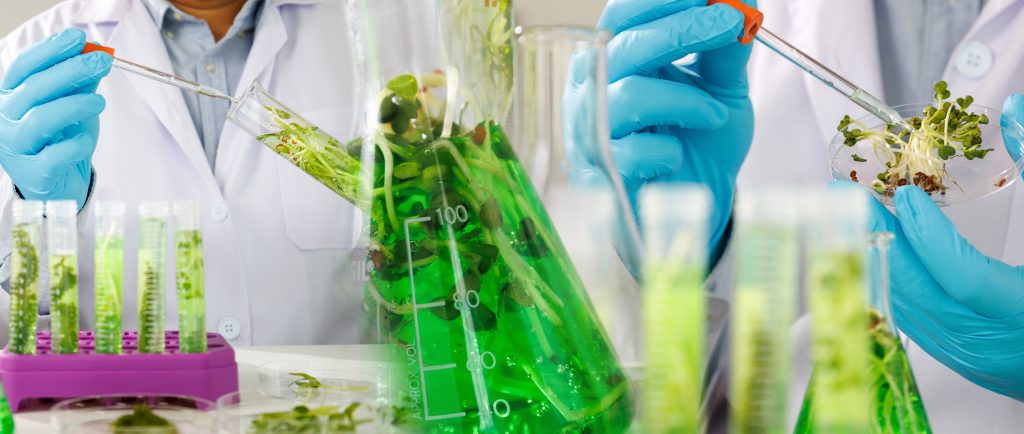
Real-time Infection Monitoring
Researchers from the Centre for Aerosol Impacts on Climate and the Environment (CAICE), the California Centre for Algae Biotechnology (Cal-CAB), and the Centre for Marine Biotechnology and Biomedicine (CMBB) proposed chemical ionisation mass spectrometry (CIMS) as a real-time monitoring technique, which could identify infections introduced by grazers and the impacts these have on the growth of algal communities.
Algal cultures produce small molecules and volatile gases as by-products of their metabolic reactions during healthy population growth and in response to environmental stressors. Dr Pomeroy and his colleagues suggested that measuring changes in the volatile gases produced by algae could provide an indication of algal population health in a pond, as the volumes and compositions of the gases produced are controlled by factors such as environmental conditions, nutrient availability, light levels, growth rate and the presence of contaminants.
To test the CIMS method, the team measured the gases produced by the cyanobacteria Synechococcus elongatus during healthy growth periods. In CIMS, an ionised gas is continuously mixed with volatile gases emitted from a sample inside a container. As the gases mix, interactions between the ions in the injected gas and molecules in the sample gas cause ionisation of the volatile gases. These ionised gas molecules can then pass through a detector and are separated out by mass spectrometry, an analytical tool which measures the mass and charge of molecules.
By analysing the results of mass spectrometry, Dr Pomeroy’s team were able to detect the different chemical compositions of gases within samples taken from an algal pond. Steps were also taken to simplify the method, such as continuous measurement of ambient gases, which could easily be observed and eliminated from the sample results. Additionally, the injection of the ionised gas was conducted gently, preventing fragmentation of ions, which would create more ions to be detected by the mass spectrometer and therefore complicate the results. As CIMS can monitor up to 10 samples an hour, the researchers hope that this method can be further modified for use in the field to improve the applicability of this technique in real-world situations and enhance the cost-effectiveness of the process.
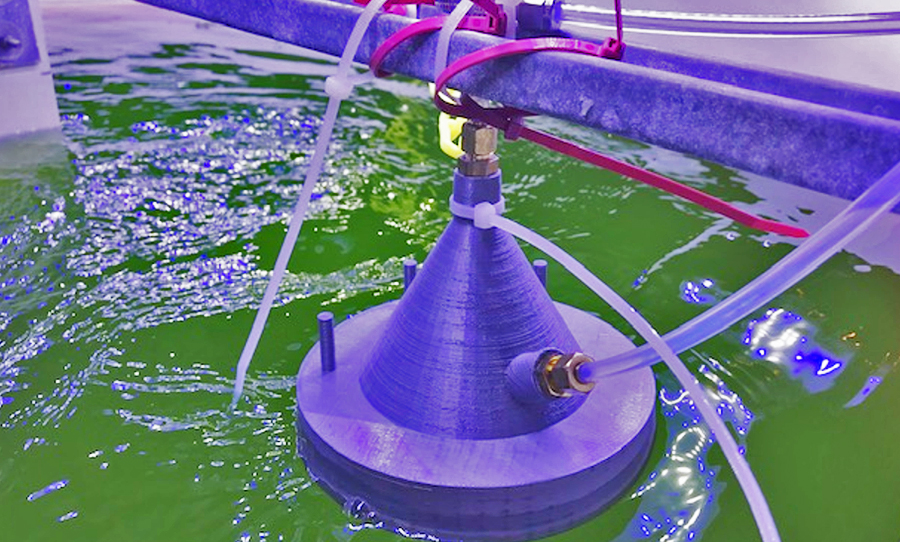
Credit: Carolyn Fisher
Finding Pests Quickly
Using CIMS, the molecule sulcatone (6-methyl5-hepten-2-one) was identified as a metabolic indicator for the freshwater cyanobacteria Synechococcus elongatus. This molecule is a by-product generated during the exponential growth of the cyanobacterial community and the gas’s abundance suggests the population is growing healthily.
Synechococcus populations were grown in 20-litre containers and monitored over 28 days. Tetrahymena (a single-celled organism) was added to the container, introducing an infection as Tetrahymena rapidly grazes on Synechococcus. Liquid samples were collected from the containers for daily analysis using microscopy, absorbance spectroscopy and fluorescence spectroscopy to cross-reference with CIMS data. Sterile air was also bubbled through the liquid sample to push gases to the surface and it is these gases that were fed into CIMS for analysis. The mass spectrometer produced 60,000 readings in 1 second, making sample analysis very rapid, and specific peaks on the graph (mass spectrum) revealed the compositions of the volatile gases being produced. In total, 49 ions were found to change in intensity over the lifetime of the experiment, indicating that biological processes were occurring within the algal culture in response to the injection of Tetrahymena.
After only 18 hours, nitrogen-based gases, such as ammonia and pyrroline, became more abundant during measurements, suggesting that these gases can help to indicate the presence of grazing species (such as Tetrahymena). CIMS was able to identify these changes in gas compositions much more quickly than traditional methods (such as microscopy and continuous fluorescence) which took between 25 and 76 hours longer than the CIMS method to detect infections introduced by Tetrahymena. The more timely detection of infection using CIMS is imperative for growers, as the method provides an early warning of contamination and gives growers time to respond to prevent biomass losses.
However, Dr Pomeroy and colleagues noticed that some of the higher density algal samples tested during the study showed a heightened response to microorganism infection than more sparsely populated samples. The denser samples produced larger changes in volatile gas volumes in response to the stressful stimuli (infection), suggesting that the CIMS method would be most successful to monitor dense, mature algal ponds, and that raceway ponds with less biomass may require additional analysis to provide a full picture of the algal community’s health.
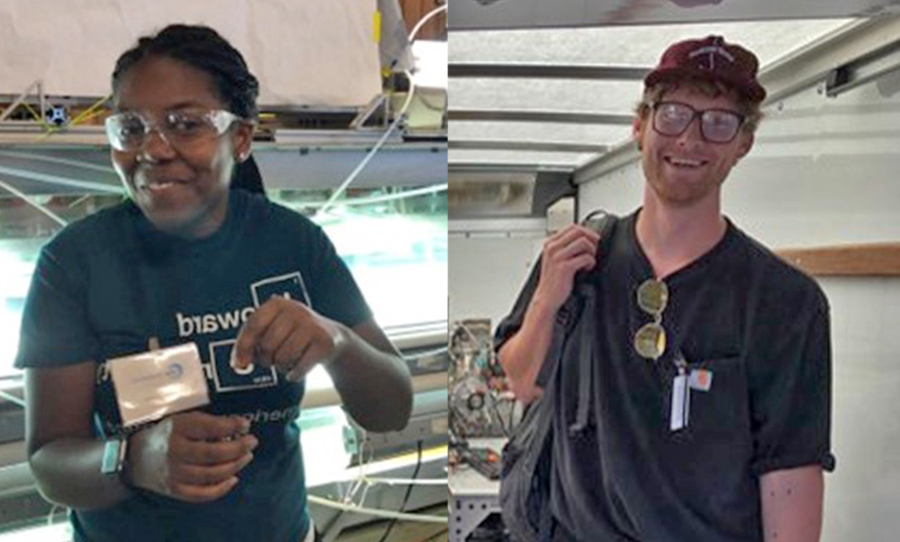
Alexia Moore and Jon Sauer. Credit: Ryan Simkovsky.
Refining Use in the Field
This new method shows promise to be an effective tool for continuous monitoring of volatile metabolites to identify grazing in algal ponds. Future research will refine the technique to work on more specific algal-grazer relationships, which will account for variations in the volatile gases produced by different algal species and unwanted microorganisms. Additionally, modifying the method to work in situ at raceway ponds will require addressing environmental contaminants separate from the infecting microorganisms. Dr Pomeroy and colleagues propose a solution to this, by using a sampling interface across a large surface area of pond water, where the CIMS equipment is positioned next to a stream of clean air to minimise local airborne sources of contamination.
Volatile gases provide a proxy for the state of health of the algal bloom, therefore, harnessing the power of CIMS can provide a 1-to-3-day notice of upcoming biomass loss following infection. Identifying infections early can allow for treatment to protect the biomass in ponds and therefore reduce biomass losses for the energy industry. Furthermore, this pest monitoring technique could have wider applicability in other industries that require strict levels of hygiene, such as in the production of beer, cheese, antibodies and laboratory-grown meats. Predators, pathogens and competitors within raceway ponds reduce biomass quality and yield. Clearly, CIMS has the potential to prevent crop destruction by infectious species and increase the profitability of biomass production.
SHARE
DOWNLOAD E-BOOK
REFERENCE
https://doi.org/10.33548/SCIENTIA911
MEET THE RESEARCHER
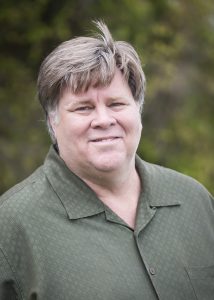
Dr Robert Pomeroy
Department of Chemistry and Biochemistry
University of California
San Diego, CA
USA
Dr Robert ‘Skip’ Pomeroy is an Analytical Chemist and Teaching Professor at the University of California, San Diego. Before teaching here, Dr Pomeroy also obtained his Bachelor of Arts degree in Chemistry at the same university, followed by a Master of Science degree in Analytical Chemistry from Cal Poly Pomona. His education continued with a PhD in Analytical Chemistry from the University of Arizona and a postdoctoral position in the Marine Physical Lab at Scripps Institution of Oceanography. Dr Pomeroy now works across several research centres (Centre for Aerosol Impacts on Climate and the Environment, California Centre for Algae Biotechnology, FF21 and the Centre for Renewable Materials), serving as an educational lead and chemical analyst, and has spent 10 years leading research and development for Southern Grouts and Mortars.
CONTACT
E: rpomeroy@ucsd.edu
W: https://www-chem.ucsd.edu/faculty/profiles/pomeroy_robert_s.html
KEY COLLABORATORS
Dr Ryan Simkovsky, University of California, San Diego
Dr Susan Golden, University of California, San Diego
Dr Kimberly Prather, University of California, San Diego
Dr Michael Burkart, University of California, San Diego
Dr Timothy Bertram, University of California, San Diego
Dr Pieter Dorrestein, University of California, San Diego
FUNDING
US Department of Energy Grant DE-EE0007094
FURTHER READING
JS Sauer, R Simkovsky, AN Moore, et al., Continuous measurements of volatile gases as detection of algae crop health, Proceedings of the National Academy of Sciences of the United States of America, 2021, 118(40), e2106882118. DOI: https://doi.org/10.1073/pnas.2106882118
DD Nguyen, JS Sauer, LP Camarda, et al., Grazer-induced changes in molecular signatures of cyanobacteria, Algal Research, 2022, 61, 102575. DOI: https://doi.org/10.1016/j.algal.2021.102575
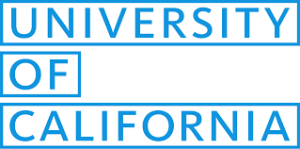
REPUBLISH OUR ARTICLES
We encourage all formats of sharing and republishing of our articles. Whether you want to host on your website, publication or blog, we welcome this. Find out more
Creative Commons Licence (CC BY 4.0)
This work is licensed under a Creative Commons Attribution 4.0 International License. 
What does this mean?
Share: You can copy and redistribute the material in any medium or format
Adapt: You can change, and build upon the material for any purpose, even commercially.
Credit: You must give appropriate credit, provide a link to the license, and indicate if changes were made.
SUBSCRIBE NOW
Follow Us
MORE ARTICLES YOU MAY LIKE
Dr Robert Larkin | Cultivating Change to Improve Soil Health and Increase Potato Yield
Environmental quality and food production are facing the pressing challenges of climate change and global population growth. Dr Robert Larkin from the United States Department of Agriculture-Agricultural Research Service (USDA-ARS) and a team of plant scientists developed and tested a range of crop management systems to help overcome these compounding challenges. Their work is improving soil health and increasing the yield of potato crops, contributing to the future food security of nations.
Dr Arne Stensvand | Thermotherapy: Effective Disease and Pest Management Without Chemicals
Dr Arne Stensvand and his team at the Norwegian Institute of Bioeconomy Research are developing physical methods of pest reduction in plants. The team is specifically interested in strawberry plants, for which pest management is vital for crop success. They are pioneering thermotherapy as a heat treatment method to provide an environmentally effective and economically sound non-chemical approach to pest management.
Dr. Daniel Canfield | Reprioritising Pollution Reduction in Florida’s Lakes
Florida’s landscape is dotted with thousands of lakes that reflect regional geology, topography and anthropogenic activities. Phosphorus and nitrogen are critical nutrients for maintaining the wide range of biological production expressed across Florida, but excessive inputs of these nutrients due to past human activities impair many waters. There has been a long history of work aiming to address associated water quality pressures, and Dr. Daniel Canfield at the University of Florida has been at the centre of these efforts for over 40 years. Now, with the correction of point-source nutrient inputs, Dr. Canfield proposes that holistic lake management, including the integration of in-lake management strategies with a focus on organic sediment removal, should be much more prominent on the US government’s agenda to provide faster restoration of stakeholders’ lake usability.
Dr Jon Tore Lieng | Dynamically Installed Anchors for Floating Offshore Turbines
Effectively harnessing offshore wind presents a valuable opportunity to increase energy supplies. Floating wind turbines present several advantages over traditional fixed turbines in more shallow waters. Dr Jon Tore Lieng from Deep Sea Anchors and colleagues have developed a type of dynamically installed anchor to hold the structures in place while reducing both the costs and complexity associated with installation where cohesive seabed sediments are realised.

